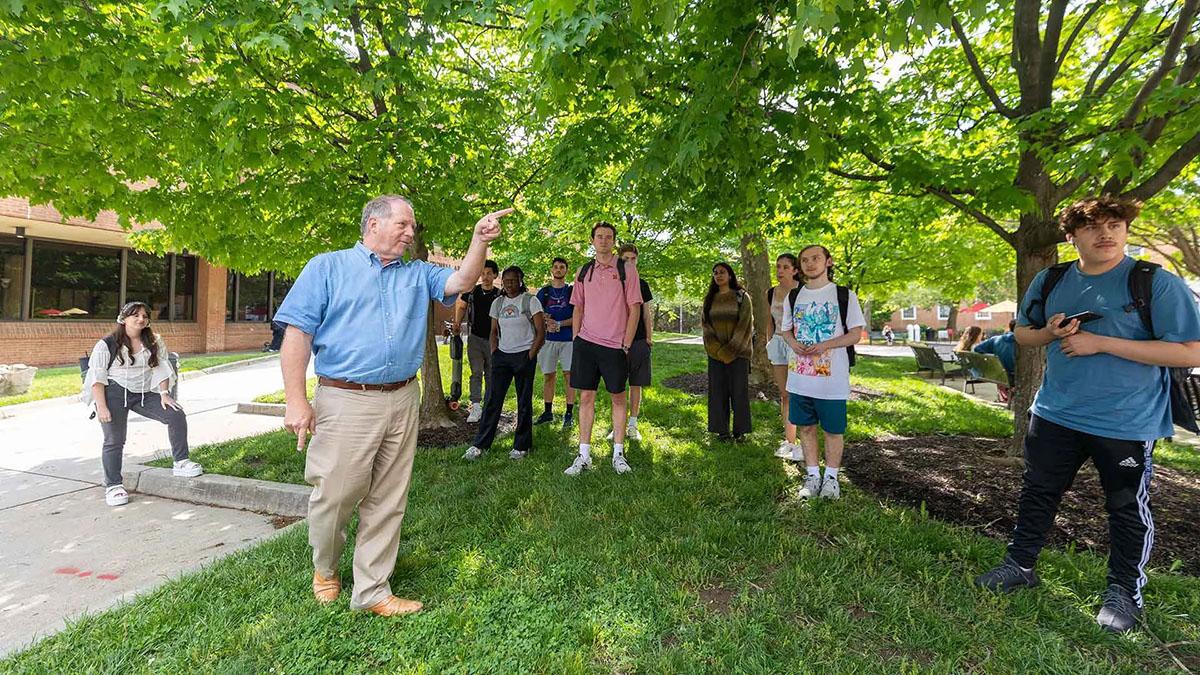This story originally appeared in Maryland Today.
The seven floors of books, offices and resources at the University of Maryland’s McKeldin Library house plenty of facts, but one thing about the building is pure fiction: Step outside, and you’ll count just four stories—an intentional design trick (thanks to oversized windows) that makes the building appear imposing and impressive from a distance, and the people walking by it smaller.
This nugget of architectural trivia sets the tone for “The Everyday and the American Environment,” a historic preservation course that challenges students to look a bit closer at the buildings, streetscapes and landscapes they regularly encounter to discover meanings and messages hidden in plain sight.
“Things aren’t necessarily what they seem,” said Postdoctoral Associate Stefan Woehlke, one of the course’s instructors. “There are intentions behind how things are designed to influence how people think, or even behave, (in ways) that are almost subliminal.”
Through walking tours, class discussions and other activities, Woehlke and his colleagues teach students to “read” a landscape by exploring a variety of places and examining the social forces that influenced their change over time. From the cobblestone streets of Georgetown to the Baltimore Avenue corridor, they consider the evolution of architectural styles, historic events like gentrification, the influence of culture and politics, and generational change. They also delve into the question of what gets to be deemed “historic.”
“It’s interesting how shifting perspectives over time have changed how and what we preserve,” said computer science major Shivank Bhimavarapu ’27. “I’m thinking a lot more about why a building might still be here today and how it was used in the past.”
Of special consideration are narratives often overlooked, such as Black and immigrant spaces; a section on the Shaw neighborhood and U Street corridor— which originated from Camp Barker, a Civil War contraband camp held by the Union Army until the D.C. Emancipation Act—walks students through the physical growth and change of what was once one of the nation’s most affluent Black communities.
Students also uncover unfamiliar histories of deeply familiar places; class projects challenge them to delve into buildings, neighborhoods and landscapes with personal meaning to them. This semester’s class, taught by Lecturer John Sprinkle Jr., has students tackling sections of College Park, combining hand-drawn maps and photography to tell stories of campus history and change.
“I think it’s so easy to be preoccupied with your thoughts and walk past so many aspects of our environment without noticing them,” said bioengineering student Pantea Vafaei ‘26. “This class has put some things into perspective for me and made me appreciate parts of campus I didn’t consider before.”
In the last workshop of the semester, students examined how music influences the way people engage with and remember a place: College Park haunts like the Cornerstone Grill, with its sticky floors and thumping sound system, or the quiet of McKeldin Mall in the late afternoon, all add to our perceptions of a space as much as the architecture or landscape.
“Everyday life is multisensory and, just like what’s in your field of vision, those sounds and smells are also changing,” said Sprinkle. “It actually helps having the Purple Line (construction) happening right now; students are seeing all of these issues of space and noise and how people are experiencing this area now, but are also thinking about how the next generation will experience it too.”
Most students who take this class, said Woehlke, aren’t history or architecture majors; many don’t fully understand what historic preservation is on the first day of class. But its popularity is evident by a frequent waitlist (which included one student who called Sprinkle to plead for a spot this spring).
The summer version, with its smaller class size and shorter timespan—just 15 class days in all—will largely take place outside the classroom and include weekly field trips. While the course is a gen-ed twofer (satisfying two requirements for undergraduates), Woehlke hopes it does more than check a box.
“Students are often disheartened by the challenges we face today,” he said. “When they leave this course, I hope they realize that changes are possible in the world, and they can help make those changes happen faster than they think.”

